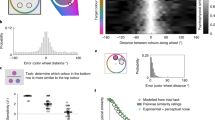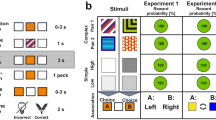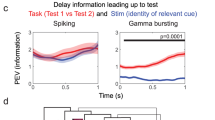Abstract
Why are some spatial patterns remembered more easily than others? There are many possible mechanisms underlying spatial working memory function. Here, the author explores different mechanisms simultaneously in a single conceptual model. He conducts a large-scale experiment (35.4 million responses used to measure human observers’ spatial working memory across 80,000 patterns) and builds a convolutional neural network as a benchmark for what is expected to be explainable. The author then creates a quasi-comprehensive exploration model of spatial working memory based on classic concepts, as well as new notions, including spatial uncertainty, Bayesian integration, out-of-range responses, averaging, grouping, categorical memory, line detection, gap detection, blurring, lateral inhibition, chunking, multiple spatial-frequency channels, redundancy, response bias and random guess. This model provides a tentative overarching framework for the mechanisms of spatial working memory.
This is a preview of subscription content, access via your institution
Access options
Access Nature and 54 other Nature Portfolio journals
Get Nature+, our best-value online-access subscription
$29.99 / 30 days
cancel any time
Subscribe to this journal
Receive 12 digital issues and online access to articles
$119.00 per year
only $9.92 per issue
Buy this article
- Purchase on Springer Link
- Instant access to full article PDF
Prices may be subject to local taxes which are calculated during checkout







Similar content being viewed by others
Data availability
All data can be found on the Open Science Framework https://osf.io/makdg/.
Code availability
All scripts used for data analysis can be found on the Open Science Framework https://osf.io/makdg/.
Change history
19 May 2023
A Correction to this paper has been published: https://doi.org/10.1038/s41562-023-01613-w
References
Watts, D. J. Should social science be more solution-oriented? Nat. Hum. Behav. 1, 0015 (2017).
LeCun, Y., Bengio, Y. & Hinton, G. Deep learning. Nature 521, 436–444 (2015).
Schmidhuber, J. Deep learning in neural networks: an overview. Neural Netw. 61, 85–117 (2015).
Dwyer, D. B., Falkai, P. & Koutsouleris, N. Machine learning approaches for clinical psychology and psychiatry. Annu. Rev. Clin. Psychol. 14, 91–118 (2018).
Goldstone, R. L. & Lupyan, G. Discovering psychological principles by mining naturally occurring data sets. Top. Cogn. Sci. 8, 548–568 (2016).
Peterson, J. C., Abbott, J. T. & Griffiths, T. L. Evaluating (and improving) the correspondence between deep neural networks and human representations. Cogn. Sci. 42, 2648–2669 (2018).
Glaser, J. I., Benjamin, A. S., Farhoodi, R. & Kording, K. P. The roles of supervised machine learning in systems neuroscience. Prog. Neurobiol. 175, 126–137 (2019).
Awad, E. et al. The moral machine experiment. Nature 563, 59–64 (2018).
Peterson, J. C., Bourgin, D. D., Agrawal, M., Reichman, D. & Griffiths, T. L. Using large-scale experiments and machine learning to discover theories of human decision-making. Science 372, 1209–1214 (2021).
Agrawal, M., Peterson, J. C. & Griffiths, T. L. Scaling up psychology via scientific regret minimization. Proc. Natl Acad. Sci. USA 117, 8825–8835 (2020).
Pashler, H. Familiarity and visual change detection. Percept. Psychophys. 44, 369–378 (1988).
Wheeler, M. E. & Treisman, A. M. Binding in short-term visual memory. J. Exp. Psychol. Gen. 131, 48–64 (2002).
Xu, Y. D. Limitations of object-based feature encoding in visual short-term memory. J. Exp. Psychol. Hum. Percept. Perform. 28, 458–468 (2002).
Olson, I. R. & Jiang, Y. H. Is visual short-term memory object based? Rejection of the ‘strong-object’ hypothesis. Percept. Psychophys. 64, 1055–1067 (2002).
Alvarez, G. A. & Cavanagh, P. The capacity of visual short-term memory is set both by visual information load and by number of objects. Psychol. Sci. 15, 106–111 (2004).
Zhang, W. W. & Luck, S. J. Discrete fixed-resolution representations in visual working memory. Nature 453, 233–235 (2008).
Bays, P. M. & Husain, M. Dynamic shifts of limited working memory resources in human vision. Science 321, 851–854 (2008).
Huang, L. Unit of visual working memory: a Boolean map provides a better account than an object does. J. Exp. Psychol. Gen. 149, 1–30 (2020).
Brady, T. F. & Alvarez, G. A. Contextual effects in visual working memory reveal hierarchically structured memory representations. J. Vis. 15, 6 (2015).
Brady, T. F. & Tenenbaum, J. B. A probabilistic model of visual working memory: incorporating higher order regularities into working memory capacity estimates. Psychol. Rev. 120, 85 (2013).
Orhan, A. E. & Jacobs, R. A. A probabilistic clustering theory of the organization of visual short-term memory. Psychol. Rev. 120, 297 (2013).
Bae, G.-Y., Olkkonen, M., Allred, S. R. & Flombaum, J. I. Why some colors appear more memorable than others: a model combining categories and particulars in color working memory. J. Exp. Psychol. Gen. 144, 744 (2015).
Brady, T. F. & Alvarez, G. A. Hierarchical encoding in visual working memory: ensemble statistics bias memory for individual items. Psychol. Sci. 22, 384–392 (2011).
Langlois, T. A., Jacoby, N., Suchow, J. W. & Griffiths, T. L. Serial reproduction reveals the geometry of visuospatial representations. Proc. Natl Acad. Sci. USA 118, e2012938118 (2021).
Langlois, T. et al. Passive attention in artificial neural networks predicts human visual selectivity. Adv. Neural Inf. Process. Syst. 34, 27094–27106 (2021).
Rudin, C. Stop explaining black box machine learning models for high stakes decisions and use interpretable models instead. Nat. Mach. Intell. 1, 206–215 (2019).
Huttenlocher, J., Hedges, L. V. & Duncan, S. Categories and particulars: prototype effects in estimating spatial location. Psychol. Rev. 98, 352 (1991).
Müller, N. G., Mollenhauer, M., Rösler, A. & Kleinschmidt, A. The attentional field has a Mexican hat distribution. Vis. Res. 45, 1129–1137 (2005).
Nemes, V. A., Whitaker, D., Heron, J. & McKeefry, D. J. Multiple spatial frequency channels in human visual perceptual memory. Vis. Res. 51, 2331–2339 (2011).
Csathó, Á., van der Vloed, G. & van der Helm, P. A. Blobs strengthen repetition but weaken symmetry. Vis. Res. 43, 993–1007 (2003).
Treder, M. S. & van der Helm, P. A. Symmetry versus repetition in cyclopean vision: a microgenetic analysis. Vis. Res. 47, 2956–2967 (2007).
Sternberg, S. The discovery of processing stages: extensions of Donders’ method. Acta Psychol. 30, 276–315 (1969).
Huang, L. Color is processed less efficiently than orientation in change detection but more efficiently in visual search. Psychol. Sci. 26, 646–652 (2015).
Huang, L. FVS 2.0: a unifying framework for understanding the factors of visual-attentional processing. Psychol. Rev. 129, 696 (2022).
Huang, L. & Pashler, H. A Boolean map theory of visual attention. Psychol. Rev. 114, 599–631 (2007).
Jolly, E. & Chang, L. J. The flatland fallacy: moving beyond low–dimensional thinking. Top. Cogn. Sci. 11, 433–454 (2019).
Acknowledgements
The work described in this paper was supported by the Research Grants Council of Hong Kong (CUHK 14610520 awarded to L.H.). The funder had no role in study design, data collection and analysis, decision to publish or preparation of the manuscript. I am grateful to Entelligence (www.eletell.com) for integrating the present experiment into their mobile app ‘Light of the Future’ and to H. Xu for his valuable advice on neural networks.
Author information
Authors and Affiliations
Contributions
L.H. is the sole author of this article.
Corresponding author
Ethics declarations
Competing interests
The author declares no competing interests.
Peer review
Peer review information
Nature Human Behaviour thanks Jordan Suchow and the other, anonymous, reviewer(s) for their contribution to the peer review of this work. Peer reviewer reports are available.
Additional information
Publisher’s note Springer Nature remains neutral with regard to jurisdictional claims in published maps and institutional affiliations.
Supplementary information
Supplementary Information
Supplementary Sections 1–8, Figs. 1–5 and Tables 1 and 2.
Rights and permissions
Springer Nature or its licensor (e.g. a society or other partner) holds exclusive rights to this article under a publishing agreement with the author(s) or other rightsholder(s); author self-archiving of the accepted manuscript version of this article is solely governed by the terms of such publishing agreement and applicable law.
About this article
Cite this article
Huang, L. A quasi-comprehensive exploration of the mechanisms of spatial working memory. Nat Hum Behav 7, 729–739 (2023). https://doi.org/10.1038/s41562-023-01559-z
Received:
Accepted:
Published:
Issue Date:
DOI: https://doi.org/10.1038/s41562-023-01559-z
This article is cited by
-
Scaling up behavioural studies of visual memory
Nature Human Behaviour (2023)



